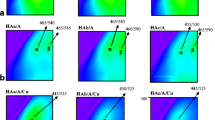Abstract
The ability of eight soil microfungal species,Alternaria alternata, Clonostachys rosea f.rosea, Exophiala cf.salmonis, Fusarium cf.coeruleum, Fusarium redolens, Paecilomyces lilacinus, Penicillium canescens andPhoma sp., and two known basidiomycete humic acid (HA) degraders,Trametes versicolor andPhanerochaete chrysosporium, to modify fluorescence properties of fulvic acids (FA) and/or HAs was determined. Effects of minerals and/or glucose on the modifications were examined. FA purified on polyvinyl-polypyrrolidone (PVPP) chromatography column was used. Purification of FA on PVPP column removed the low-molar-mass FA-structural components and excess of extractant (NaOH) used during FA preparation. Excitation spectra of FA entering the purification, purified FA and the removal solution indicate that organic compounds rich in carboxylic groups dominate in the removal solution and higher content of phenolic groups is a characteristic of purified FA. Many microfungal species shifted the emission maximum (measured at 470 and 468 nm of excitation wavelength) of FA, and also HA to longer wavelengths. The opposite effect (shift of the HA emission maximum to shorter wavelengths) of microfungi was observed for HA complemented by glucose. Depending on the presence of glucose in the medium, most microfungi changed also the shape of the emission spectra of HA and FA and the excitation spectra of FA. HA excitation spectrum measured at 590 nm of emission wavelength was significantly affected by the presence of glucose. Mineral ions caused a minor shift in the position of excitation maximum (measured at 590 nm of emission wavelength) toward longer wavelengths.
Similar content being viewed by others
References
Aiken G.R., McKnight D.M., Wershaw R.L., MacCarthy P.:Humic Substances in Soil, Sediment, and Water. John Wiley & Sons, New York 1985.
Chen J., LeBoeuf E.J., Dai S., Gu B.: Fluorescence spectroscopic studies of natural organic matter fractions.Chemosphere 50, 639–647 (2003).
Chin Y.P., Aiken G., O’Loughlin E.: Molecular weight, polydispersity, and spectroscopic properties of aquatic humic substances.Environ.Sci.Technol. 28, 1853–1858 (1994).
Chin Y.P., Traina S.J., Swank C.R., Backhus D.: Abundance and properties of dissolved organic matter in pore waters of a freshwater wetland.Limnol. Oceanogr. 43, 1287–1296 (1998).
Gramss G., Günther T., Fritsche W.: Spot tests for oxidative enzymes in ectomycorrhizal, wood- and litter-decaying fungi.Mycol. Res. 102, 67–72 (1998).
Gramss G., Ziegenhagen D., Sorge S.: Degradation of soil humic extract by wood- and soil-associated fungi, bacteria, and commercial enzymes.Microb.Ecol. 37, 140–151 (1999).
Gryndler M., Hršelová H., Klir J., Kubát J., Votruba J.: Long-term fertilization affects the abundance of saprotrophic microfungi degrading resistant forms of soil organic matter.Folia Microbiol. 48, 76–82 (2003).
Kästner M.: “Humification” process of formation of refractory soil organic matter, pp. 349–378 in J. Klein (Ed.):Environmental Processes II, Vol. 11b, 2nd ed. Wiley VCH, Weinheim (Germany) 2000.
Kluczek-Turpeinen B., Steffen K.T., Tuomela M., Hatakka A., Hofrichter M.: Modification of humic acids by the compost-dwelling deuteromycetePaecilomyces inflatus.Appl.Microbiol.Biotechnol. 66, 443–449 (2005).
Koukol O., Gryndler M., Novák F., Vosátka M.: Effect ofChalara longipes on decomposition of humic acids fromPicea abies needle litter.Folia Microbiol. 49, 574–578 (2004).
McKnight D.M., Boyer E.W., Westerhoff P.K., Doran P.T., Kulbe T., Anderson D.T.: Spectrofluorimetric characterization of dissolved organic matter for indication of precursor organic materials and aromaticity.Limnol.Oceanogr. 46, 38–48 (2001).
Mobed J., Hemmingsen S.L., Autry J.L., McGown L.B.: Fluorescence characterization of IHSS humic substances: total luminescence spectra with absorbance correction.Environ.Sci.Technol. 30, 3061–3065 (1996).
Piccolo A., Nardi S., Concheri G.: Macromolecular changes of soil humic substances induced by interactions with organic acids.Eur.J.Soil.Sci. 47, 319–328 (1996).
Pitt J.I.:The Genus Penicilliumand its Teleomorphic States Eupenicilliumand Talaromyces. Academic Press, London 1979.
Schlesinger W.H.:Biogeochemistry. An Analysis of Global Change, 2nd ed. Academic Press, San Diego (USA) 1997.
Senesi N., Miano T.M., Provenzano M.R., Brunetti G.: Characterization, differentiation, and classification of humic substances by fluorescence spectroscopy.Soil Sci. 152, 259–271 (1991).
Senesi N., D’Orazio V.: Fluorescence spectroscopy, pp. 35–52 in D. Hillel (Ed.):Encyclopedia of Soils in the Environment. Academic Press, Amsterdam (The Netherlands) 2005.
Sierra M.M.D., Giovanela M., Parlanti E., Soriano-Sierra E.J.: Fluorescence fingerprint of fulvic and humic acids from varied origins as viewed by single-scan and excitation emission matrix techniques.Chemosphere 58, 715–733 (2005).
Silva M.R.: Estudos potenciométricos e fluorimétricos dos equilibrios ácido-básicos e da complexação de metais com o Obisdien e as substáncias húmicas. Contaminação pelos metais em sedimentos da Ilha de Santa Catarina (Brasil).PhD Thesis. Universidade Federal de Santa Catarina, Santa Catarina (Brazil) 1996.
Strnadová V., Hršelová H., Kolařík M., Gryndler M.: Response of saprotrophic microfungi degrading the fulvic fraction of soil organic matter to different N fertilization intensities, different plant species cover and elevated atmospheric CO2 concentration.Folia Microbiol. 49, 563–568 (2004).
Takeuchi T., Sumida J.: Indirect detection of halide ionsvia fluorescence quenching of quinine sulfate in microcolumn ion chromatography.Anal.Sci. 20, 983–985 (2004).
Author information
Authors and Affiliations
Corresponding author
Rights and permissions
About this article
Cite this article
Řezáčová, V., Gryndler, M. Fluorescence spectroscopy: a tool to characterize humic substances in soil colonized by microorganisms?. Folia Microbiol 51, 215–221 (2006). https://doi.org/10.1007/BF02932125
Received:
Revised:
Issue Date:
DOI: https://doi.org/10.1007/BF02932125




